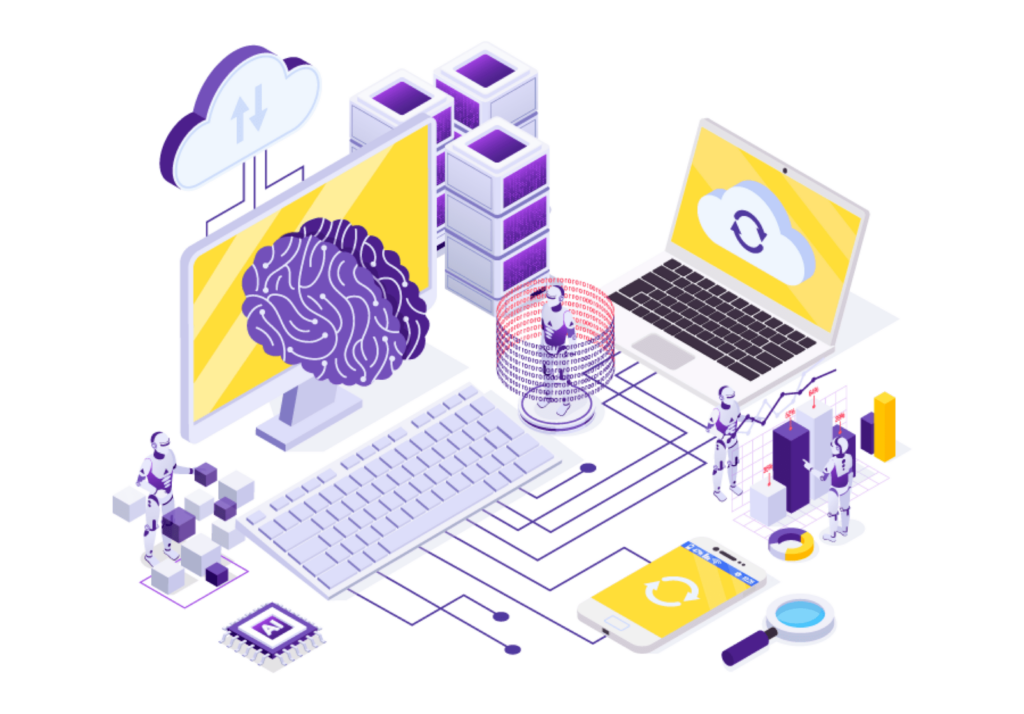Table of Content
Data operations (DataOps) is an important topic in business discussions— as it is a method for generating data analytics for decision-making and market insights.
Organizations with innovative data analytics operations are profiting from AI solutions and creating competitive advantages.
Implementing AI solutions in a large organization requires good data management practices. Data quality, management, and processing capabilities are critical for responding to queries with on-demand or instant analytics for decision-making.
What is DataOps?
Data operations or DataOps are data management practices that promote the communication, integration, and automation of data operations processes to deliver data analytics.
Data analytics processes and operation executions create outputs through reports or visualizations. For example, data engineers use dashboards to visualize and monitor the pipeline’s state, alerts, and results of automated tests.
DataOps Evolves from Agile Development and DevOps Practices
DataOps in an evolution of Agile and DevOps practices. The company data goes through a series of operations that follow instructions and procedures with proper observation, testing, and measurement methods to control the output quality.
Data engineers practice agile methodologies, optimizing code and data analytics delivery, collaborating and communicating, creating feedback loops, and developing iteratively in small increments.
DataOps Pipeline Process
The data pipeline is an end-to-end analytics process where data and logic are tested for validating assumptions and detecting trends, errors, and anomalies (during the input/output phases). The pipeline is measured with automated testing methods such as statistical process control (SPC) (data tests) and test suites (to validate new code) to keep the process under control.
Automatic Building, Testing, and Deployment
Data Analytics teams improve the process by building tests after each iteration to verify its work against business assumptions or expectations. Also, testing helps determine the causes of errors and prevent repeating them.
Version Control of Source Code
The data pipeline is defined by a logic coded with scripts and uses tools and configurations to control the process and make it reproducible. Data analytics teams maintain all artifacts (repositories) in a version control system (VCS) for managing or facilitating changes and revisions (updating code source files).
Data engineers make changes to the pipeline in parallel using pipeline branches that are tested and then merged to the trunk (trunk-based development).
Environment Isolation
Team members can develop new features using datasets in their environments or sandbox test environments, running their tests to experiment and learn before merging with the source code.
Replicable Procedures
Data engineers create components (microservices) or modules in containers to build specific functions and parameters into the pipeline to simplify the reutilization of code and its deployment to other environments.
A data pipeline performs the operation of analytics that is orchestrated and managed as a lean manufacturing line, where raw data is used to create value while reducing waste and improving efficiencies.
DataOps Tools
DataOps practices establish the use of tools and processes to optimize data workflows by automating the process and creating data quality outputs (analytics).
DataOps is about orchestrating data to production and improving the speed (velocity) of developing analytics features. Using the tools and methodologies of DataOps focuses on improving cycle time and data quality.
Combination of tools to implement DataOps :
- Data Processing Workflow (Apache Airflow Orchestration)
- Data Transformation (ETL/Streaming)
- Version Control (GIT)
- Testing and Monitoring
- Environment (Jenkins)
Data Analytics Production or Value Pipeline
Data is variable and goes through many steps for accessing, transforming, modeling, and reporting. Therefore, data engineers create and implement data tests to ensure that the quality of data values is acceptable throughout the pipeline stages and guarantee its integrity (without disruptions).
Data Development and New Models
Data engineers also continuously create new data insights (analytics) or update the data pipeline to satisfy internal requests (from data analysts). They must develop analytic features that usually takes new algorithms and works with fixed data sets (representative data set) while validating and committing new code changes. New analytics code is tested and verified before deployment.
DataOps orchestrates the data operations pipeline with the development pipeline in a unified workflow. New ML models are tested and added to the value pipeline.
Test Data Management Challenges
DataOps teams must replicate data and its infrastructure to work or explore new features. Therefore, engineers automate the development environments with data, tools, and libraries to reduce complexities in managing data testing.
DataOps Platforms
DataOps can automate the pipeline using a DataOps platform instead of working with individual DataOps components to help simplify the process and streamline data engineering tasks. Programmable platforms such as Google Cloud Big Query, Databricks, and AWS, offer good functionality and help to orchestrate, test, and monitor the data operations (DataOps) pipeline.
Data Engineers
Data engineers can build data sets and analytics features after a thorough understanding of data usefulness and analytics, which calculations can be reusable, data duplications, integration errors, and many other data characteristics to determine data pipeline improvements.
Also, they stabilize the data processes, create data lakes and data warehouses, and perfection the tools to process and promote the utilization and integration of automation.
Data engineers master orchestration with continuous monitoring and deployment, which makes them very productive and can focus on new customer requirements for delivering analytics.
Data Organization
Client organizations use data and analytics to provide valuable information or functionality to other systems such as CRM, Warehouse Management systems, or external partners. As the data becomes more advanced, it requires higher quality and precision and transitioning to higher level teams within the data organization to create new developments or more complex functionality.
To become a data organization, teams must have multiple members contributing and interacting with good collaboration and communication. But data management practices must help to create a vision of the end-to-end pipeline with a shared purpose. In addition, it should create synergies for the standardization of tools, process coordination, iteration cycle, cadence, and integration challenges.
DataOps Improves Team Efficiency
Agile leadership creates the right environment and conditions for self-sufficient teams, balancing the freedom and centralization that data teams need to prosper.
Data-agile teams align their organizational model and optimal team structures to achieve their desired data architectures and adapt to the operating context and users of analytics outcomes (outcome-based team).
Take Away
Many organizations want to leverage data for their decision-making, let it be through data analytics or AI. However, to get to the point where value can be extracted from the data, teams have to work together in streamlining the data engineering process so clean, high-quality data is delivered to data scientists, data analysts, and teams that use data for their decision-making.
Remember, a machine learning model will learn the patterns of the data. However, if you feed it with good-quality data, the model will yield good predictions.
DataOps promotes the orchestration of data pipelines (workflows)—methodologies and defined data processes that guide your workflows and integration with AI solutions.
Businesses build a strategy to extract data value with a supporting data architecture and operating model with technical and functional domain expertise.
Most companies are generating data but need to realize its potential. At Krasamo, the DataOps team can help you operationalize data for your organization.












I’m super hyped about this DataOps post!!! It’s giving me all the feels about data pipeline automation and how it can revolutionize AI solutions! Have you guys explored any DataOps tools that simplify data management and processing capabilities? I’m thinking about implementing a data operations platform to streamline our data pipeline!